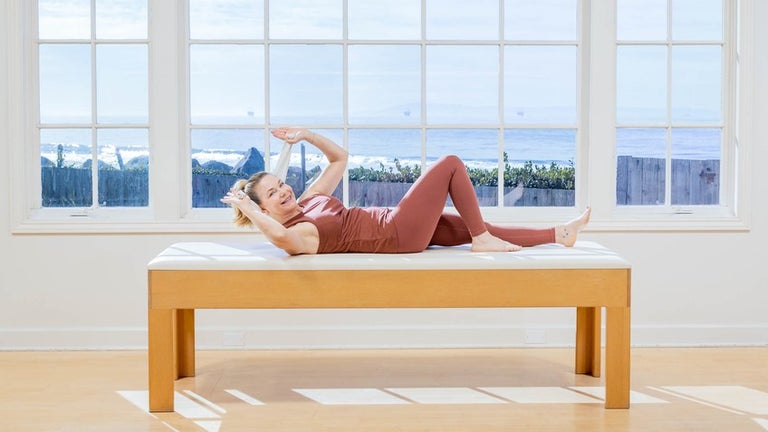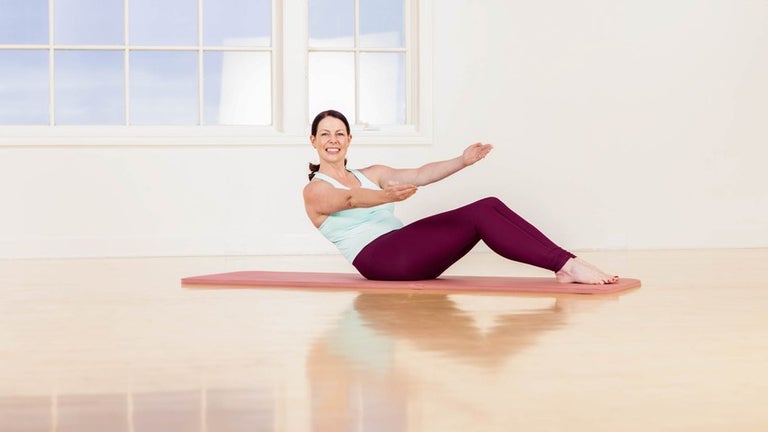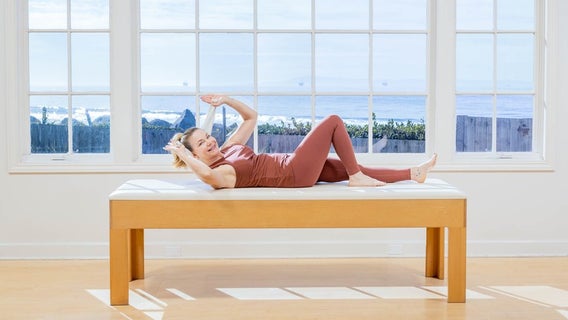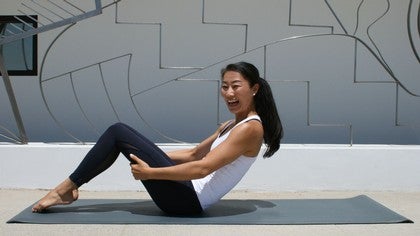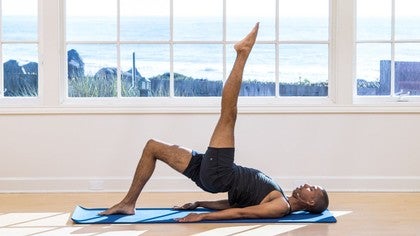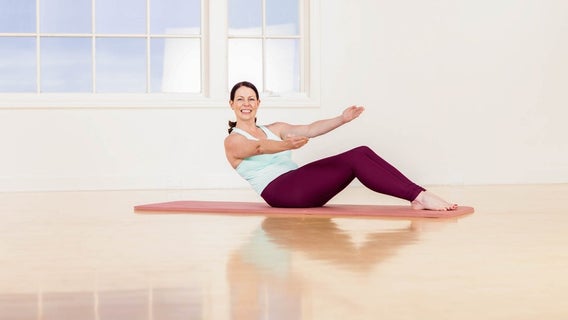Mat Pilates for Beginners
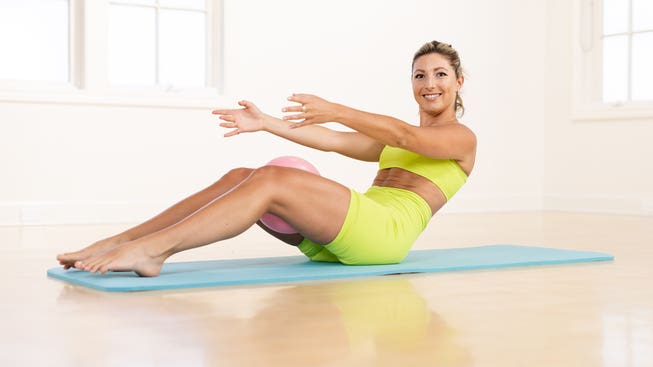
Mat Pilates for Beginners
Mat Pilates is a strengthening and lengthening form of exercise that focuses on your core (trunk) muscles while also training your arms and legs. Mat Pilates is based on the original exercises Joseph Pilates developed to strengthen his own body as a young man. Pilates Mat work originated before the creation of any Pilates equipment or “machines” used in the practice today and includes over 500 exercises that can be practiced anywhere. Mat Pilates can be modified for any age, body, or fitness level, and it is even possible to practice modified Mat work in a chair.
The Benefits of Mat Pilates
Pilates is a mind, body, and spirit practice with benefits that include improved posture, better coordination and balance, increased lung capacity, improved concentration and focus, increased body awareness, stress management, and injury prevention. Mat work is a great choice for all levels of Pilates practitioners because the exercises not only can build in difficulty, but every exercise can also be modified to decrease or increase the level of challenge. Practicing Mat Pilates helps build a strong, balanced body and increases flexibility. As you progress in your practice, you will notice improvements in breathing, focus, and body awareness. Mat Pilates is perfect for beginners because you only need your own body, a Mat, and some floor space to start.
Tips and Advice for Beginners
Mat Pilates classes are a great option for those new to a Pilates practice. Group classes and private sessions taught by a trained Pilates teacher are offered in Pilates studios and also some gyms. You may also choose to begin a home practice with the help of books, videos, or online streaming services like Pilates Anytime. Take your time and don’t assume you are going to work the same muscles you’ve used in other forms of exercise. Don’t get frustrated if you can’t do every exercise perfectly. Pilates is called a practice for a reason – it requires focus and dedication. Give yourself permission to slow down and make movements smaller so that you can properly execute the exercises. To start, opt to take class at least twice a week and don’t be afraid to get on the Mat and try some of the exercises at home.
Beginner Pilates Mat Exercises
Beginner Mistakes to Avoid on the Mat
When beginning your Pilates practice, don’t get frustrated, as it is a new focus on your body and how it moves. Oftentimes, we move too quickly or try to make large movements and miss the point of the exercise. Make every movement a bit smaller. Remember that you are working to stabilize one portion of your body while moving another. If your work feels like all leg work, make the work smaller and focus on your breath and your abdominal engagement. Don’t forget to breathe – a huge portion of finding proper engagement comes from your breath work. Cues like "sink your belly button to your spine" can be confusing at first. However, the cue refers to the feeling of allowing your ribs to relax toward your hips while your belly button is pulled toward your spine on an exhale to engage your abdominal muscles. You will feel a pulling up of your pelvic floor (lower abdominals – think below the hips) muscles even though your pelvis won’t move or tip. Pilates will not be easy right away and that’s okay! Allow yourself to enjoy the process of learning about your body and moving in a new way. Have fun with it!
Mat Modifications for Beginners
Don’t be afraid to use modifications offered for the Pilates exercises. Bent knees versus straight legs, adding extra head and neck support, and even moving through the exercises at a slower pace are all acceptable modifications. A Pilates teacher will tell you that the number one thing is not to get hurt. Listen to your body and if an exercise feels off or too strenuous, modify or skip that exercise. Some Pilates Mat classes may include small props, such as Magic Circles, Overballs, and Therabands to increase your challenge and help you find the right muscle groups to use for each exercise. Make sure you understand how to use these props correctly to get the most out of your exercise.
Featured Mat Classes
Thousands of Mat Pilates videos to choose from in our ever growing Pilates library.
Beginners Ready for Intermediate Classes
Once you feel like you are able to perform beginner Pilates exercises with good form and deliberation, you will experience both the feeling that the work is easier and that you can find more work or muscle engagement within each exercise. This is a great sign that you are ready to add intermediate Mat classes to your routine. Joseph Pilates famously said, "In 10 sessions you’ll feel different, in 20 sessions you’ll notice a difference, in 30 sessions you’ll have a whole new body." This may or may not be your experience, but the only way for your Pilates practice to be effective, no matter your goals, is to practice regularly. Practicing Pilates a minimum of twice a week is a good start.
Tips and Advice for Intermediate Classes
If you have been practicing Mat Pilates for a while and feel like you are ready for the next level, you can take a private class with a Pilates teacher to learn some new exercises. Pilates teachers are knowledgeable, as they go through intense training programs of at least 450 hours initially. An instructor will help you take your practice to the next level and avoid common beginner mistakes. You could also begin a Reformer Pilates practice, if you haven't done so already.
Mat Pilates Frequently Asked Questions
What should you do if you feel discomfort or pain?
First and foremost, listen to your body. If you are feeling pain, stop immediately. If an exercise causes discomfort (not muscle engagement but actual discomfort), try one of the modifications. An example would be a bent knee versus legs extended or smaller movements than your range of motion dictates. If you still feel uncomfortable, skip that exercise for now and come back to it in a few weeks.
How often should you exercise on the Mat?
Early in your Pilates practice, you are just starting to make changes that include finding the time to practice Pilates. Since you need consistent practice to improve your performance of the exercises, aim for at least two Pilates sessions per week to start. If you can practice more, go for it! You may enjoy the Mat work so much that you want to practice every morning or each night for 15 or 20 minutes. Let your body dictate your frequency as you progress.
How to find a good Pilates teacher?
You can find a great Pilates Mat teacher anywhere! Mat classes are oftentimes less expensive and larger than Reformer or equipment classes. A Pilates studio is one of the best places to begin and many trained Pilates instructors teach at gyms, athletic clubs, or local community centers. The key is to take classes from Pilates teachers who have been through a minimum of a 450-hour comprehensive training program. Online resources like Pilates Anytime are another option since we bring some of the best Pilates teachers in the world into your living room for your own "private" Mat class.
Your Pilates Anytime Membership Benefits
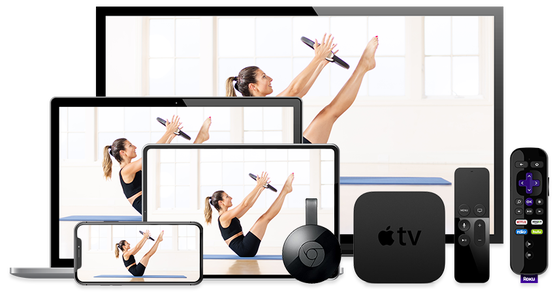
- 15-Day Free Trial
- Unlimited Access to Thousands of Classes
- 95+ Pilates Programs and Challenges
- No Ads
- New Videos Weekly
- Available on All Your Favorite Devices
